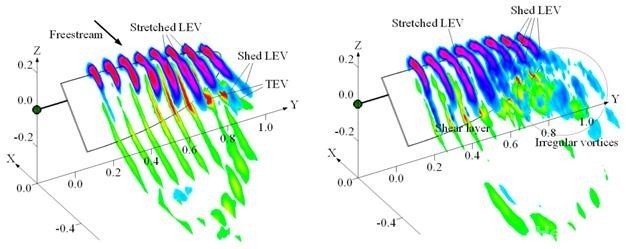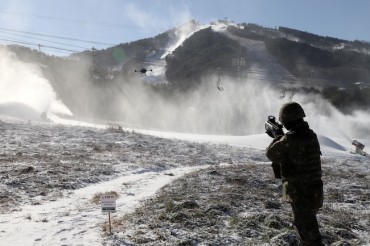
The experiment led to the discovery that increasing the velocity by more than 25 percent relative to the speed of wing stroke can destabilize the vortices’ structure (R), which was why insects were using the most efficient “advance ratio” (flight velocity versus speed of wing stroke) of 25 percent or below (L). (image: Yonhap)
DAEJEON, Nov. 10 (Korea Bizwire) – Korea Aerospace University scientists have discovered the fundamentals of insect flight, using a newly developed “insect robot”.
According to the team, most insects use a flying method that creates spiraling vortices around the wings, which allows for stable flight even in sudden gusts. Although there have been scientific studies conducted to explore what enabled the sustained formation of the vortices, it has been difficult given insects’ small size and extremely rapid wing movements.
The researchers’ insect robot took the shape of a convolvulus hawk-moth (agrius convolvuli), only five times bigger.
The experiment itself took place underwater in a towing tank, with the robot’s wings flapping 250 times slower than an actual insect, but with the capacity to generate 10 times greater force for better observation.
Upon monitoring the changes of force and in the vortices as the robot advanced forward, the researchers discovered that an insect’s maximum flight velocity is determined by how well the vortices are sustained. The vortices were also found to almost double the intensity of the insect’s lift force, the team added.
The experiment also led to the discovery that increasing the velocity by more than 25 percent relative to the speed of wing strokes can destabilize the vortices’ structure, which was why insects were using the most efficient “advance ratio” (flight velocity versus speed of wing strokes) of 25 percent or below.
Furthermore, the team’s analysis on wing shape and its effect on flight indicated that a three to one ratio between wing width and length is most optimal for the formation of stable vortices and greater aerodynamic force.
And while vortices were formed at the tip in wider wings, they were formed towards the body, at the wings’ roots, when wings were smaller.
“It’s the first study that revealed the optimal velocity and wing shape in insect flights,” said professor Chang Jo-won, who led the research. “Our discovery will be highly applicable in future generation drones and wing mechanisms of UAVs.”
The full research findings were published in the November 3 edition of Journal of Fluid Mechanics.
By Joseph Shin (jss539@koreabizwire.com)






